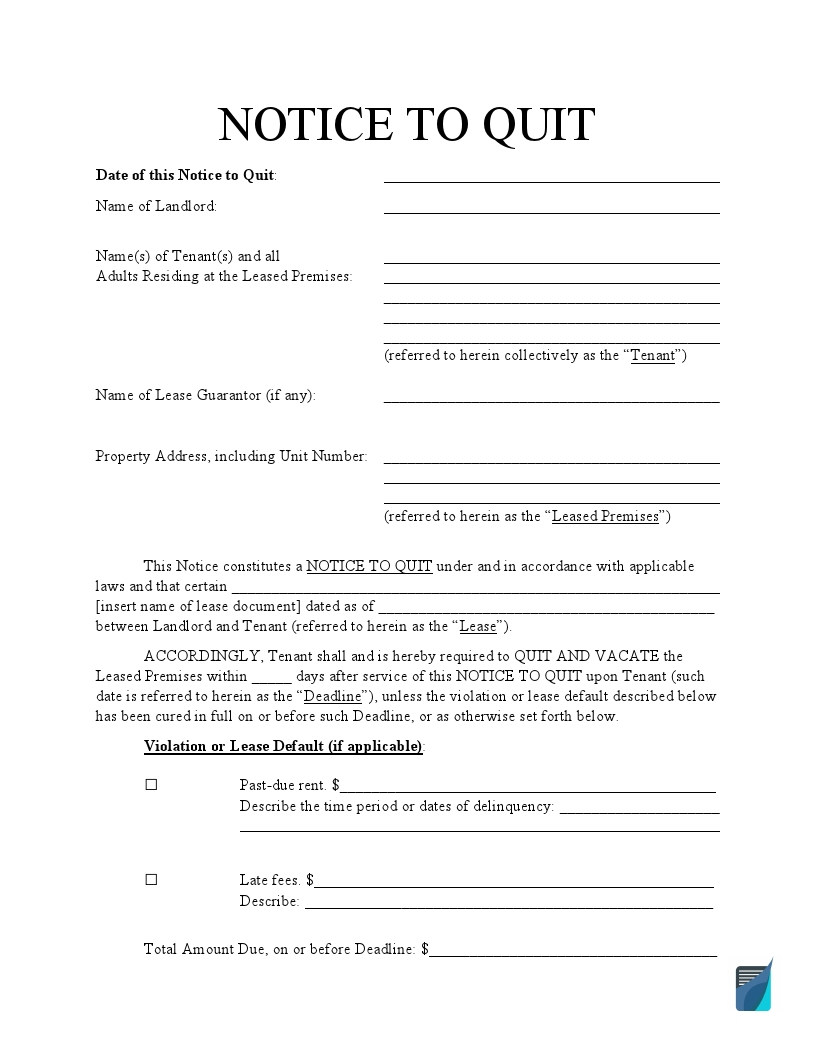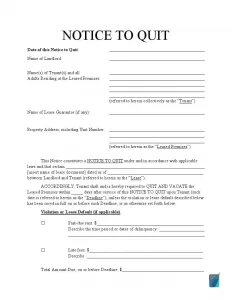60-Day Notice to Vacate Template
A 60-day notice to vacate is a form used by a landlord to demand the tenant to move out of the rental property. A 60-day notice can be required to be given when a tenant has been living at the property for more than one year. If the tenant has been living at the property for less than one year, then only a 30-day notice is required to be given to ask the tenant to vacate.
While no particular reason is required to be given while sending this notice, it is commonly sent for non-payment of rent, breach of the lease agreement, or for conducting illegal activities at the property.
In California and Delaware, a landlord must give 60 days to end a periodic (for example, month-to-month) tenancy. The requirements of this notice are:
- Be in writing
- State the full name of the tenant or tenants
- State the full address of the rental property
- Clearly state that the tenancy will end after the expiry of 60 days

Build Your Document
Answer a few simple questions to make your document in minutes
Save and Print
Save progress and finish on any device, download and print anytime
Sign and Use
Your valid, lawyer-approved document is ready
What is the Effective Date of a 60 Days Notice?
- In California, sixty days are counted from the day following the date of serving of the notice. For example, if the notice was served on July 16, sixty days will begin from July 17.
- In Delaware, the time frame of sixty days begins from the first day of the month following the day actual notice is given. It is usually used for tenancies at will by either party.
60-Day Eviction Notice to Vacate Form Details
| Document Name | 60-Day Eviction Notice to Vacate Form |
| Other Names | 60-Day Notice to Quit, Sixty-Day Eviction Notice |
| Avg. Time to Fill Out | 13 minutes |
| # of Fillable Fields | 55 |
| Available Formats | Adobe PDF |

Filling Out the 60 Day Notice Form
FormsPal’s customizable and easy-to-use eviction notice template can be filled out by following these simple steps:
Notice Period
Fill out the notice period as 60 in all blanks where “_ Day Notice” is mentioned.
Date
Fill out the notice date. Enter the date correctly, as the sixty-day period will be calculated based on this date.
Party Details
Enter the full legal name of the landlord, tenant(s), and lease guarantor (if any), as mentioned in the corresponding lease agreement.
Property Location
Fill out the full address of the leased property, including the state, city, and zip code.
Lease Details
Fill out the date of the original lease contract. If you are unable to recall it, check the original contract to avoid mistakes.
Select and Describe the Reason
Select the reason for sending the notice. If the reason is the conduct of illegal activities, select option one. Mention in short the kind of illegal activities and how you came to know about them.
In case the reason is violations of the lease, select option two. Describe the violations made and point to the clauses from the contract that contain the terms in question. For example, if there was an unauthorized stay of guests at the property, mention the clause from the agreement forbidding it.
And if the reason is nonpayment of rent, select option three and specify the total amount due and the due date.
Select the Follow Up Action and Cure
If the reason for sending the notice is criminal activities at the property, select the first option and the number of days within which the property should be vacated.
If the basis for sending the notice is violations of the lease, choose the second option, mention what the tenant can do to cure the violation and how much time they have.
If you are sending the notice for nonpayment of rent, select the third option, specify the total amount owed, and state the closing date by which the payment must be delivered.
Enter the Notice Serving Details
In the last part, enter all the details relating to the service of the sixty-day notice, mention the landlord’s name, and if an authorized representative is sending the notice, mention his or her name.
Pick the method of delivery and specify the forwarding address and names of all the tenants. Sign the notice, enter the state and county and get it notarized if there is such a requirement in your state.
What Happens After the Tenant Gets a 60-Day Notice?
After the notice is sent, if the tenant paid the due rent in full, the landlord cannot proceed with eviction. If the tenant pays only a part of the whole amount owed, it is the landlord’s choice to accept it or not. If accepted, this partial payment will be viewed as partial assent, so the eviction is stopped.
Likewise, if the rental contract violations have been addressed in full, the landlord cannot evict the tenant. If the tenant made only partial amendments, it is the landlord’s discretion to accept or reject it.
If no payment of due rent is made or if the lease violations are not addressed by the tenant, then legal action can be taken against the tenant. Similarly, for the conduct of illegal activities, if the property is not left by the tenant within the time mentioned, then court action may be initiated to forcibly evict the tenant.
In California, a landlord can file an “unlawful detainer” to initiate legal proceedings. In Delaware, an action for “summary possession” can be initiated against the tenant.